You might think that the placement of CO detectors isn’t that important, but it’s actually essential for early warning. Many myths suggest open windows or ventilation prevent CO buildup, but improper placement can still leave you vulnerable. Installing detectors in the right spots—near bedrooms, ceilings, and appliances—ensures you catch leaks early. To protect your home and loved ones, understanding the best placement strategies can make all the difference; learn more to stay safe.
Key Takeaways
- Proper detector placement ensures timely alerts, preventing CO buildup before symptoms appear.
- Installing detectors near fuel appliances and garages allows early leak detection and reduces poisoning risk.
- Incorrect placement near vents or humid areas can cause false alarms or missed detection.
- Mounting detectors at optimal heights and locations maximizes sensitivity and early warning capabilities.
- Strategic placement complements maintenance, ensuring reliable performance and effective indoor CO safety.
Common Misconceptions About Carbon Monoxide Risks
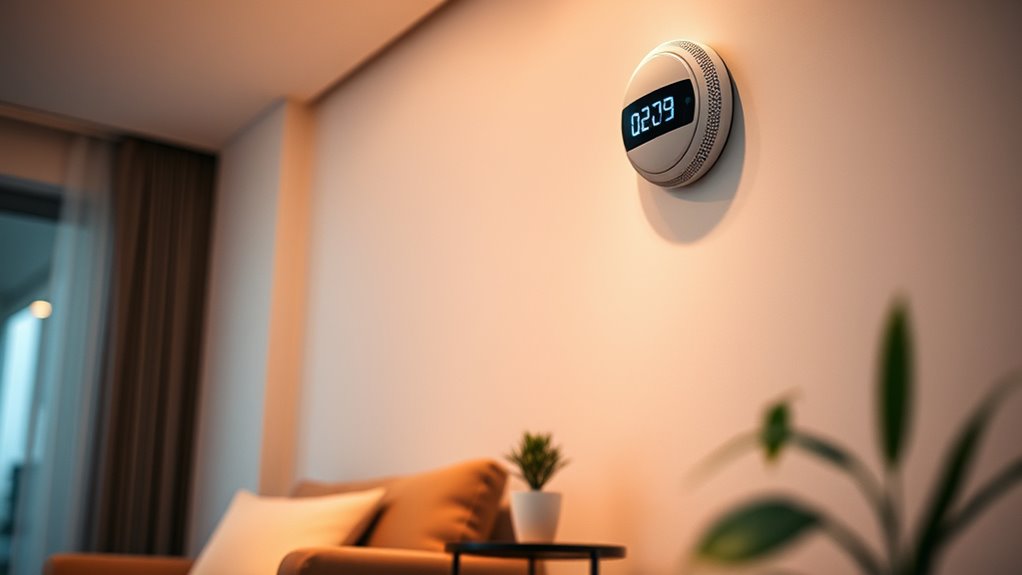
Have you ever believed that carbon monoxide poisoning only happens in poorly ventilated basements or during winter? Many people think it’s only a risk when heaters run nonstop or in cold months. But in reality, carbon monoxide leaks can occur anytime, anywhere, making fire safety and emergency preparedness essential year-round. People often underestimate the danger, assuming that proper ventilation or open windows prevent exposure. However, malfunctioning appliances, blocked vents, or even vehicle exhaust can lead to dangerous CO buildup indoors. To protect yourself, don’t rely solely on common misconceptions. Regularly check appliances, install detectors, and develop emergency plans. Understanding these myths helps you stay alert and prepared, reducing the risk of poisoning in unexpected situations. Additionally, projector placement plays a role in safety by ensuring that equipment is correctly installed and maintained to prevent hazards. Proper ventilation systems are also critical in preventing dangerous CO concentrations in enclosed spaces. Being aware of fire safety protocols further enhances your preparedness and helps mitigate risks associated with carbon monoxide exposure. Regular maintenance of appliances and awareness of CO detector placement can significantly improve safety outcomes. Moreover, considering unique and wicked planters for your indoor garden can improve air quality and contribute to a healthier indoor environment.
Why Placement of Detectors Is More Important Than You Think

Where you place your detectors can mean the difference between early warning and a missed threat. Many people make simple mistakes that reduce their safety, like installing them in the wrong spots. Understanding ideal locations and avoiding common errors is key to protecting yourself effectively. For example, knowing the factors that influence detector placement, such as home furnishings guidelines for secure storage, can enhance your safety measures. Proper placement also ensures that safety features like alarm sensitivity and power sources function optimally. Additionally, considering air quality factors and avoiding obstructions can significantly improve detector performance. Regularly checking and maintaining detectors according to manufacturer guidelines further ensures their reliability when needed.
Optimal Detector Locations
Proper placement of detectors can mean the difference between early warning and dangerous delay. For essential fire alarm and smoke detection, position detectors where smoke and carbon monoxide are most likely to reach quickly. Install them on each level, especially near bedrooms and common areas, but avoid placing them in drafty spots or dead air zones that can hinder detection. Ceiling mounting is usually best, about 12 inches from the ceiling, since smoke rises. Avoid placing detectors near vents, windows, or high humidity areas, which can cause false alarms. Thoughtful placement ensures you get timely alerts, giving you vital seconds to react before dangerous levels develop. Proper placement can also help in reducing false alarms and ensuring the detector functions optimally. Additionally, understanding the types of headphonel jacks can help in selecting the right equipment for your needs. Remember, strategic detector locations greatly enhance your safety and the effectiveness of your fire alarm system. Understanding detector placement is key to maximizing safety and early detection effectiveness.
Common Placement Mistakes
Even small mistakes in detector placement can substantially reduce your safety. For example, placing detectors too close to vents or windows can affect sensor calibration, causing false alarms or missed detections. Avoid mounting them in areas with high humidity or dust, which can hinder detector durability and lead to malfunction over time. Hanging detectors at incorrect heights—either too high or too low—can also impair their effectiveness, since CO tends to settle at certain levels. Additionally, neglecting to follow manufacturer guidelines on placement can compromise the device’s accuracy and lifespan. Proper positioning guarantees that the sensor remains properly calibrated and durable, providing reliable protection. When selecting a mounting location, consider the airflow patterns within the space to ensure optimal detection coverage. Ensuring that detectors are installed in accordance with industry standards helps maintain their effectiveness over time. Proper placement also involves understanding how sensor calibration can be affected by environmental factors, which is crucial for consistent performance. Additionally, being aware of environmental conditions can help prevent false alarms and ensure the detector functions correctly in the long term. Remember, a well-placed detector isn’t just about location; it’s about maintaining its integrity and ensuring it functions when you need it most. Effective placement is essential for optimizing detector performance and ensuring comprehensive safety coverage.
Impact on Safety
The placement of detectors directly influences how effectively they protect you from poisoning risks. Properly positioned CO detectors enhance fire safety and strengthen your emergency preparedness. If placed too high or too low, they may not activate promptly, delaying crucial warnings. This can be dangerous during a poisoning event or fire. Consider this table for optimal placement:
| Location | Reason |
|---|---|
| Near sleeping areas | Alerts you during sleep |
| On every level | Ensures full coverage |
| Away from vents and windows | Prevents false alarms |
| In the garage or near appliances | Detects leaks early |
Correct placement ensures your safety, giving you vital extra seconds to react and prevent tragedy. Proper detector placement is essential for effective fire safety and emergency preparedness. Additionally, placing detectors in bedrooms ensures they are within the optimal range for timely alerts during sleep. Understanding detector placement and its importance can significantly reduce the risk of unnoticed CO exposure. Proper detector positioning can also minimize false alarms caused by environmental factors.
The Truth About CO Detector Locations
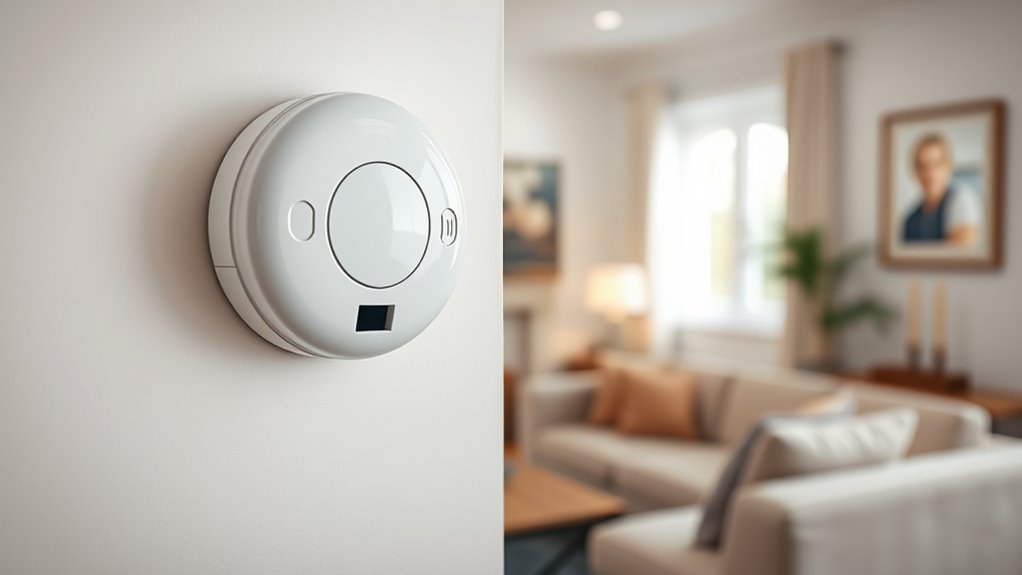
Choosing the right spots for your carbon monoxide detectors can substantially improve their effectiveness. Avoid placing them near indoor plants, as their moisture can interfere with sensor readings. Instead, install detectors on every level of your home, especially near sleeping areas. Proper placement also involves considering sensor placement best practices to ensure optimal detection. Additionally, placing detectors in high-risk areas such as near garages or fuel-burning appliances increases safety. Don’t rely solely on smoke alarms; CO detectors serve a different purpose and need proper placement. Mount detectors at least 15 feet away from fuel-burning appliances to prevent false alarms. Keep them at chest height or slightly higher for accurate detection, but avoid placing them in humid areas like bathrooms. Proper placement guarantees early warning and prevents dangerous delays in response. Additionally, placement consistency plays a crucial role in ensuring your detectors function correctly over time. Regularly testing and maintaining your CO detectors is essential to ensure their reliability, as technology updates can improve detection accuracy. Remember, the goal is to position detectors where they can quickly alert you to rising CO levels, ultimately saving lives.
How Poor Placement Can Lead to Dangerous Delays
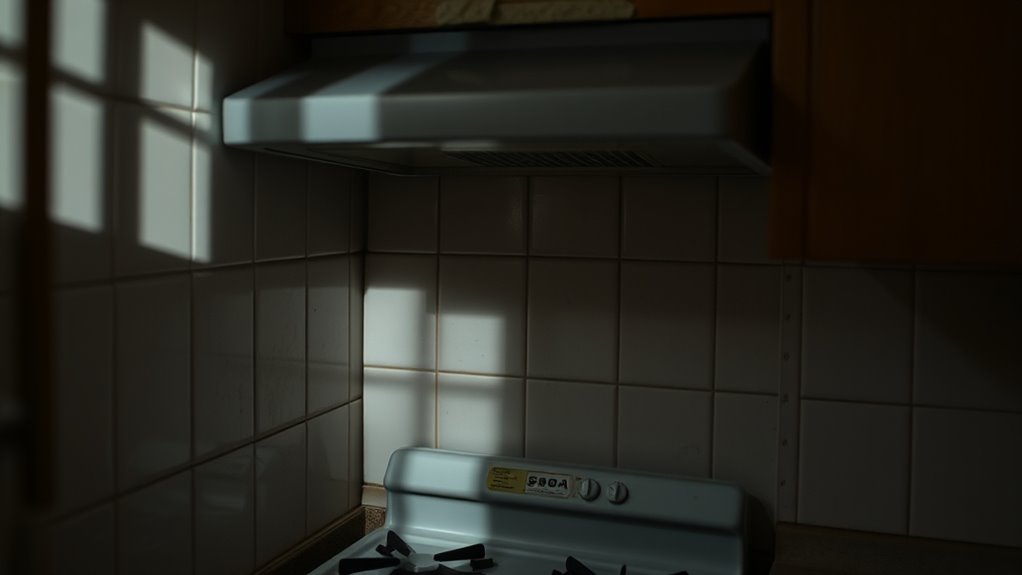
Poor placement of CO detectors can cause dangerous delays in alerting you to rising carbon monoxide levels. If you place detectors too high or too low, they might not detect CO promptly, especially if appliances or furniture block airflow. Incorrect appliance placement or cluttered furniture arrangements can create pockets where CO accumulates unnoticed. For example, placing detectors behind large furniture or near vents can slow detection. To maximize safety, understanding proper placement techniques is essential for reliable detection.
Myths About CO Poisoning Symptoms and Detection
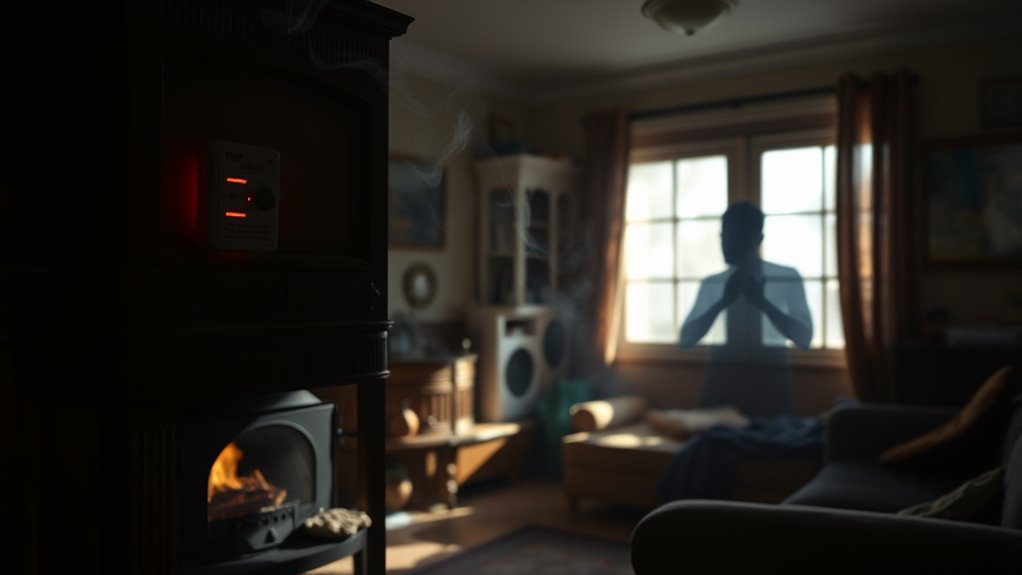
Many people believe that carbon monoxide poisoning always causes obvious symptoms, but in reality, myths about its detection can be dangerous. Poor indoor air quality from CO leaks often goes unnoticed because symptoms like headaches, dizziness, or nausea are easily attributed to other causes. Relying solely on feeling unwell to recognize CO dangers isn’t sufficient, especially for emergency preparedness. You might not notice early signs, making it vital to have working detectors and proper placement, which help identify CO presence before symptoms appear. Misunderstanding how symptoms present or assuming they’re always obvious can delay response times and increase risks. Staying informed about these myths ensures you take proactive steps to protect yourself and your loved ones from silent, deadly CO exposure.
The Role of Ventilation in CO Safety
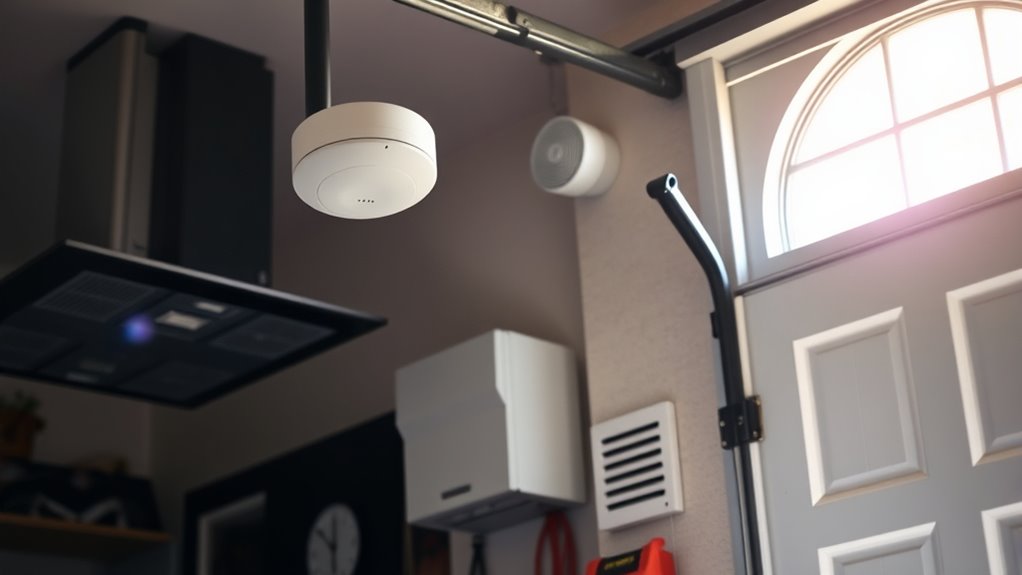
Proper ventilation is key to preventing CO buildup and keeping your home safe. You need to make sure airflow is continuous and adequate, especially near appliances that produce CO. If you notice weak or uneven airflow, it’s a sign you may need to improve your ventilation setup immediately.
Proper Ventilation Techniques
Effective ventilation is essential for preventing carbon monoxide buildup and ensuring safety when using fuel-burning appliances. You should focus on maintaining proper air circulation to keep indoor air fresh and dilute any CO that may escape. Open windows and doors regularly to promote fresh air exchange, especially when appliances are in use. Use exhaust fans in kitchens and bathrooms to remove indoor air contaminants and improve airflow. Avoid blocking vents or airflow pathways, as restricted circulation can trap CO indoors. Keep appliances properly maintained to minimize leaks and ensure efficient combustion. Proper ventilation techniques help reduce indoor air pollution and lower the risk of CO poisoning. By actively managing indoor air, you create a safer environment for everyone in your home.
Detecting Insufficient Airflow
When airflow is insufficient, carbon monoxide can quickly accumulate to dangerous levels without obvious signs. To detect this, pay attention to airflow patterns in your home. Poor ventilation can cause CO to linger unnoticed, especially if your detectors aren’t calibrated correctly. Regularly check that your CO detectors are functioning properly and calibrated according to manufacturer instructions. Use the table below to understand the impact of airflow on detection:
| Airflow Pattern | Effect on CO Levels |
|---|---|
| Properly circulated air | CO disperses quickly |
| Stagnant corners | CO concentrates, risk rises |
| Blocked vents | CO buildup, detection delayed |
| Inadequate ventilation | CO accumulates unnoticed |
| Correct detector placement | Accurate detection |
Ensuring proper airflow and calibration helps you identify insufficient ventilation early, preventing dangerous CO buildup.
Misunderstandings About CO Detector Types and Effectiveness

Many people assume all carbon monoxide (CO) detectors work the same way, but in reality, there are different types with distinct features and limitations. Some detectors focus on detector sensitivity, meaning they can detect lower CO levels more quickly, while others may have higher thresholds, risking delayed alerts. Alarm volume also varies; a loud alarm is vital for waking you if you’re asleep, but some models have softer alerts that could go unnoticed. Understanding these differences helps you choose the right detector for your home’s needs. Don’t assume that a more expensive or a newer model automatically offers better protection—check both sensitivity and alarm volume to guarantee your detector can effectively alert you during a CO emergency.
The Impact of Household Layout on CO Detector Placement
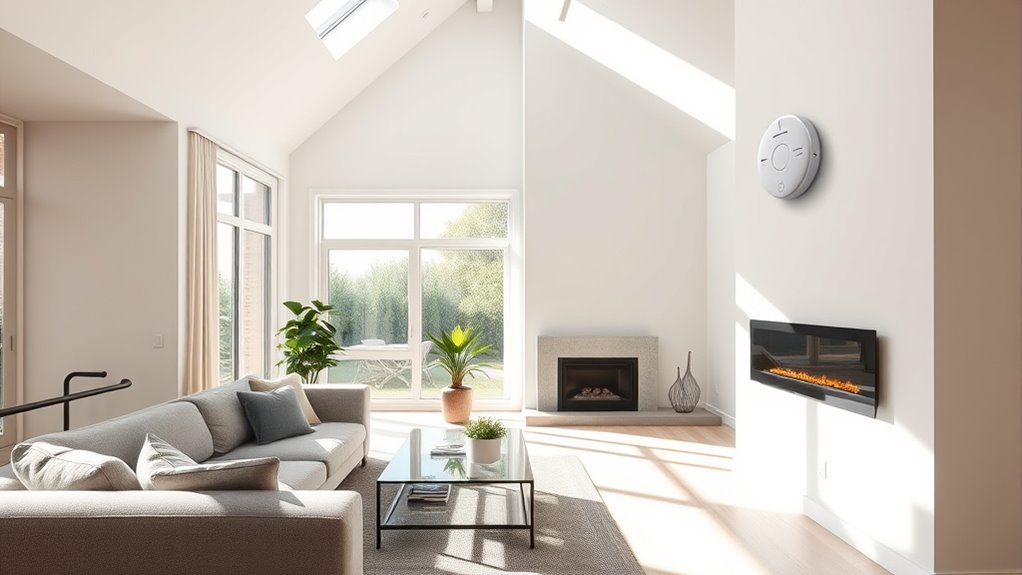
Choosing the right CO detector isn’t just about the model’s features; where you place it in your home makes a significant difference in how well it can protect you. Your household layout, including furniture placement and room size, greatly influences detector effectiveness. To optimize safety:
- Mount detectors on walls about 5 feet above the floor, avoiding furniture blocking airflow.
- Place detectors in rooms with fuel-burning appliances, ensuring they’re not obstructed by furniture.
- Avoid corners or dead zones where air circulation is limited; central locations work best.
- Install detectors in bedrooms and hallways to ensure alertness during sleep and throughout the house.
Proper placement guarantees the detector can sense CO early, no matter the room size or furniture arrangement, maximizing your safety.
Why Regular Maintenance of Detectors Is Essential
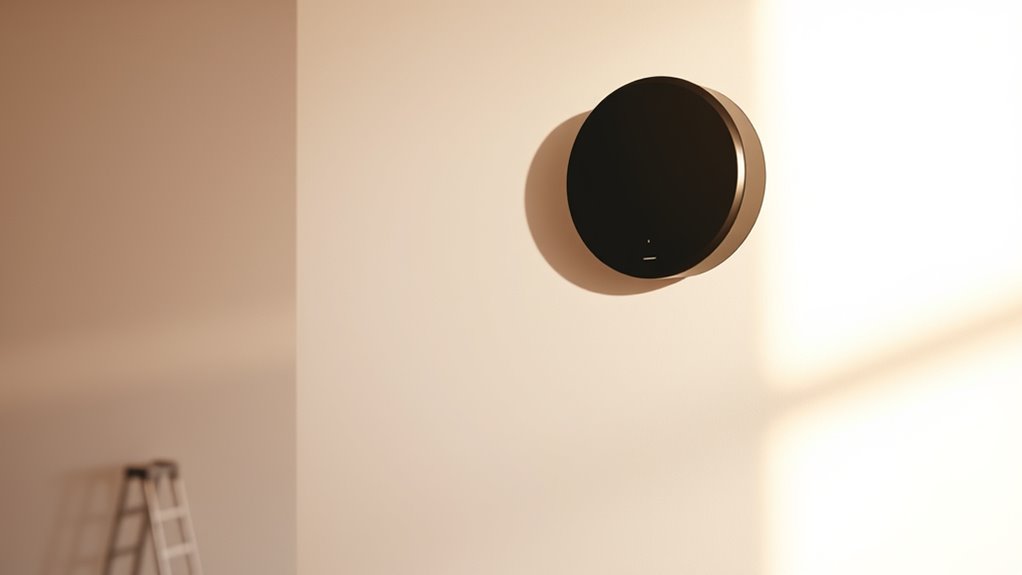
Regular maintenance of your detectors is vital to guarantee they function when you need them most. Checking batteries and cleaning sensors prevent false alarms and guarantee safety. Staying proactive with maintenance saves lives by keeping your detectors dependable.
Proper Placement Prevents Risks
Proper placement of smoke and carbon monoxide detectors is essential because even the best devices can fail if they aren’t maintained correctly. Correct placement enhances household security and strengthens your emergency preparedness. To maximize safety, consider these tips:
- Install detectors on every level, especially near sleeping areas.
- Keep them at least 10 feet from cooking appliances to reduce false alarms.
- Mount detectors high on walls or ceilings, away from vents and windows.
- Regularly check placement to ensure they are unobstructed and functioning properly.
Battery Checks Save Lives
Maintaining your smoke and carbon monoxide detectors isn’t just about correct placement; it’s about ensuring they work when you need them most. Regular battery checks are vital for effective fire safety and emergency preparedness. If the batteries die, your detector won’t alert you to danger. Schedule monthly tests and change batteries at least once a year. Use the table below to stay on top of maintenance:
| Task | When to Do It |
|---|---|
| Test detectors | Monthly |
| Replace batteries | Annually or when low battery alert sounds |
| Clean units | Every 6 months |
| Replace detectors | Every 8-10 years |
Consistent maintenance can literally save lives by ensuring your detectors function correctly during an emergency.
Expert Recommendations for Optimal CO Detector Placement

To guarantee your carbon monoxide detector provides the earliest warning, placement is critical. Proper placement ensures your indoor air stays safe and enhances your emergency preparedness. Experts recommend:
- Install detectors on every level, especially near bedrooms and living areas.
- Mount units 5-20 feet away from fuel-burning appliances to avoid false alarms.
- Place detectors at least 15 feet from windows and vents to prevent drafts from affecting readings.
- Keep detectors on the wall or ceiling, away from humid areas like bathrooms or kitchens.
Frequently Asked Questions
Can CO Detectors Be Placed Outside the Recommended Zones for Maximum Safety?
You shouldn’t place CO detectors outside the recommended zones for maximum safety. Proper detector placement follows safety guidelines to guarantee accurate detection of carbon monoxide. Installing detectors in the right locations, like near bedrooms and on every level, helps you get early warnings and protect your household. Moving detectors outside these zones can delay alerts, putting you at risk. Always follow manufacturer instructions and safety guidelines for ideal placement and safety.
How Often Should CO Detectors Be Replaced for Optimal Protection?
You should replace your CO detectors every 5 to 7 years to guarantee maximum protection. Regular detector maintenance is crucial, but even with perfect placement accuracy, batteries or sensors can degrade over time. Don’t ignore this schedule—delaying replacement could mean missing early warnings of danger. Stay vigilant, and mark your calendar. When the time comes, change them promptly to keep your home safe and your family protected from unseen threats.
Are There Specific Brands That Guarantee Better Placement Guidance?
Some brands do offer better placement guidance and guarantees to help you maximize your CO detector’s effectiveness. Look for brands with clear instructions and trusted reviews, as they often provide detailed placement recommendations. Brands like First Alert and Kidde are known for their reliable guidance and placement guarantees, ensuring you install detectors correctly for ideal safety. Always follow the manufacturer’s instructions, regardless of the brand, for the best protection.
What Are the Risks of Ignoring Placement Guidelines During Detector Installation?
Ignoring placement guidelines during detector installation risks installation errors that can lead to false alarms or missed detections. Studies show that improper placement increases false alarms by up to 50%, causing you to overlook real danger. When you don’t follow recommended guidelines, you compromise safety, risking CO buildup without warning. Proper placement ensures your detector functions correctly, providing reliable alerts when you need them most, and helps prevent dangerous CO poisoning.
How Does Household Activity Affect Optimal CO Detector Placement?
Your household activity affects CO detector placement because ventilation practices and appliance positioning influence CO levels. Place detectors near appliances that produce CO, but avoid areas with poor airflow or frequent ventilation, which can reduce detection accuracy. Active household routines, like cooking or using heating systems, require you to position detectors where they can quickly alert you to dangerous CO buildup, ensuring your safety without false alarms.
Conclusion
Remember, proper placement of your CO detector isn’t just a detail—it’s your first line of defense. Think of it as a lighthouse guiding you safely through the fog, alerting you before danger strikes. Don’t let myths cloud your judgment or poor placement delay your warning. Stay vigilant, follow expert advice, and position your detectors wisely. Because in the fight against carbon monoxide, timing and placement are your best allies—your safety depends on it.









